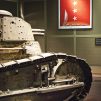National WWI Museum and Memorial: War Wheels
‘The moral climax of this, the culminating and final war for human liberty, has come.’ ––Woodrow Wilson, War Message to Congress, April 2, 1917
The National WWI Museum and Memorial honors those who died in a war no one today can recall from participation, and most Americans know little about the carnage, other than a smattering from high school history.
For its generation, it was “The Great War” and the “War to End All Wars.” The numbers, for sure, were great: The conflict, July 28, 1914, to November 11, 1918, tallied nine million combat and five million civilian deaths, from bullets and bombs, tanks and poison gas, flu and genocide. And, rather than end wars, its conclusion sparked a far worse conflagration 20 years later, with more than 60 million dead including the horrors of the Holocaust.

This year, to mark Memorial Day, May 30, Highline Autos visits the museum in downtown Kansas City, Mo., where you can experience the most comprehensive “Great War” collection in the world –– more than 500,000 items.
In 1920, the National WWI Museum and Memorial, then known as the Liberty Memorial, began collecting objects and documents from all nations involved in the First World War. Formed in 1918, The Liberty Memorial Association was the collecting institution and built both the Memorial and the Museum.
“The collection represents an international look at the conflict through the eyes of all nations that were participants,” says Doran Cart, senior curator. “The collection holds three vehicles used for transport as well as a U.S. battery wagon, a rolling kitchen with a wood wagon, a water wagon and a cook wagon. Also included is a motorcycle, a French Peugeot folding bicycle and three reproduction airplanes.”

The Museum and Memorial opened in 1926, with 150,000 spectators turning out to listen to President Calvin Coolidge deliver the keynote remarks. The Memorial was named a National Landmark in 2004, and the current National WWI Museum and Memorial, built beneath the Liberty Memorial Tower, opened in December 2o06.
Wars Move on Wheels
The earliest vehicle in the museum is a Model 1909 ambulance, among the last mule-drawn ambulances designed for the United States Army before motorized vehicles superseded them. Cart discusses this and other vehicles:

•French Renault FT17 Tank –– The tank’s original purpose was to serve as a mobile command center for battalions and provide machine gun cover. This was the first tank to be designed by Louis Renault, and 2,500 were ordered. It was also the first tank with a revolving turret and was armed with a machine gun or a 37-mm cannon. The FT17 was first used in large quantities in 1918. This actual tank was deployed in France and disabled by a German 7.7-cm artillery piece in the fall of 1918 just before the Armistice. The tank still has its original camouflage paint.
•1918 Ford Model T Truck –– When America entered the war, the federal government placed an order for 12,000 Ford Model T Trucks for the American Expeditionary Forces. More than 5,000 arrived in November 1918. The car served many roles including carrying equipment, troops and serving as ambulances. When they came off the line, they were painted black because Henry Ford opposed American involvement in the war. Any camouflage or other paint had to be added by the Army.
•1917 Harley Davidson Motorcycle –– They were first used by the Army during General Pershing’s expedition fighting Pancho Villa in 1916, during which motorcycles were equipped with a machine gun on a side car. In WWI, 20,000-plus motorcycles were used by the expeditionary forces in France. They were primarily used for reconnaissance, communications and sending wounded from the front to the hospitals.

•Motorized and Animal-Drawn Ambulances –– Two ambulances are displayed in the Main Gallery of the Museum and Memorial: a 1918 Ford Model T ambulance and the Model 1909 mule drawn-ambulance. A mule-drawn ambulance was at times advantageous to motorized vehicles because it could travel where the motorized ambulances could not. In general, an ambulance could carry four stretchers of wounded.
•German Zeppelin L49 Fabric Fragment –– A recent addition to the Museum and Memorial’s collection is a small fragment of fabric from the skin of a Zeppelin L49, one of only two items from a Zeppelin in the Museum’s collection.
On the morning of Oct. 19, 1917, 13 Zeppelins, including L49, were ordered to “attack middle England. Industrial region of Sheffield, Manchester, Liverpool, etc.” With a crew of 19 and carrying 11,000 pounds of fuel, it set out with a payload of 4,410 pounds of bombs; 42 bombs were dropped. Following the raid, L49 was forced down in France near Bourbonne-les-Bains by French fighter planes.

All crew members survived and were taken prisoner. This fabric is not currently on exhibit in the Museum and Memorial but can be found online at theworldwar.org.
If you or someone you know has a GreatGarage and would like it to be considered for an upcoming issue, please email us info@highline-autos.com. The writer thanks Karis Erwin, vice president of marketing and guest services at the National WWI Museum and Memorial, for her assistance in preparing this article.













